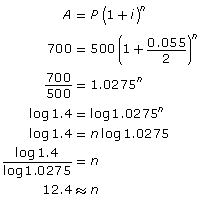In Try This 4 you may have noticed that the compound interest formula can be used to determine how long it would take for an amount of money to increase thanks to compound interest. In Scenario 1 you may have determined that it would take about 6.5 yr for the amount of money Eoghan invested to increase to $700.

The number of compounding periods is approximately 12.4. The interest is compounded semi-annually, which means there would be 2 compounding periods each year. So, the number of years would be 12.4 ÷ 2 = 6.2, or approximately 6.2 yr. To be sure the value is at least $700, the money would have to remain invested for 6.5 yr, when interest is compounded again.
The question involving the credit card would use a similar procedure, except that the credit card interest is compounded daily. The different compounding period would change how i is calculated, and n would be in days. In Scenario 2 you should have found that Jia’s payment was about 59 d overdue.
Many real-world applications can be modelled using an exponential equation. The form ![]() where b > 0, can be used to model a situation. Open
where b > 0, can be used to model a situation. Open ![]() where b > 0, and roll over each variable to explore the equation. Note that t often represents time as in this demonstration; however, it is also possible to use this form of equation when t represents something other than time.
where b > 0, and roll over each variable to explore the equation. Note that t often represents time as in this demonstration; however, it is also possible to use this form of equation when t represents something other than time.
